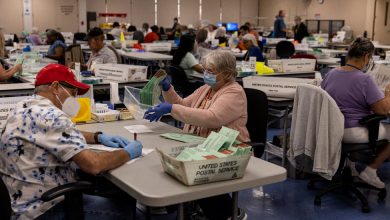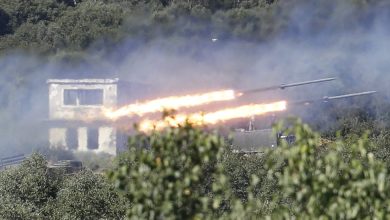Biden Expected to Offer Warnings and Alternatives in Call With Putin

President Biden is expected to offer a series of potential diplomatic offramps to President Vladimir V. Putin of Russia in a video meeting on Tuesday, but will warn him that if he orders his forces to invade Ukraine, Western allies may move to cut Russia off from the international financial system, administration officials said.
The meeting, Mr. Biden’s most critical — and most likely his highest-stakes — leader-to-leader conversation since he took office more than 10 months ago, may set the course for Ukraine’s fate as a fully independent nation. In the month since Mr. Biden dispatched his C.I.A. director, William Burns, to Moscow, Russian forces have encircled Ukraine on three sides and accelerated a cyber- and disinformation campaign to destabilize its government, according to American, European and intelligence officials.
The officials spoke on condition of anonymity to discuss Tuesday’s call.
Mr. Burns’s warnings to the Russian leader appear to have been largely ignored, officials say. The official U.S. assessment is still that Mr. Putin has not decided to conduct a full-scale invasion, officials say. But Mr. Putin and Mr. Biden, officials say, come to the conversation on Tuesday, which both men signaled they wanted, with very different agendas.
White House officials have been gaming out a series of scenarios with Mr. Biden, including that the Russian president comes with a series of demands that go well beyond the familiar one that Ukraine can never join NATO. They include a reorientation of Ukraine away from the West, and back into Moscow’s orbit.
Mr. Biden must convince Mr. Putin that the administration’s commitment to Ukraine, which it has called “unshakable,” is deep enough to cause tremendous economic pain to Russia — even if, as both men know, American forces would not come directly to Ukraine’s aid. Under discussion are steps as extreme as cutting off Russia’s access to the international financial settlement system, called SWIFT, and a series of restrictions on its banks like those honed in the effort to sanction Iran.
The offramps appear to be variations on the Minsk agreements, reached between Ukraine and Russia after the Crimea invasion — and largely ignored by the Russians since. Administration officials did not offer details of what kind of diplomatic process Mr. Biden will offer, but elements of that were hinted at by Secretary of State Antony J. Blinken in his visit to Europe last week, where he shared intelligence findings with NATO allies.
That effort appeared to begin to convince Germany, among others, that a clear warning to Mr. Putin was needed. Mr. Biden plans to speak with the leaders of Ukraine and several European allies on Monday, ahead of his call, in an effort to keep a unified front. But many European officials are clearly worried Mr. Putin could respond to pressure by diminishing gas supplies to Europe as winter approaches.
Some administration officials believe that Mr. Putin views Mr. Biden as focused on Covid at home and China abroad, and that at a moment when Germany is changing leadership and France is facing an election, this is an opportune time to begin reconstituting pieces of the old Soviet Union. They are even concerned that he may try to use Belarus, whose leader appears increasingly aligned with Mr. Putin, as a pathway to move against Kyiv.
A declassified assessment disclosed by the Biden administration late last week, in an effort to shore up opposition inside Russia to Mr. Putin’s plans, suggested that by January he may have as many as 175,000 troops on the border — up from roughly 100,000 now. But some military and intelligence officials believe that the figure may go higher, as Mr. Putin distributes his forces in a way to suggest he could try a three-sided “pincer” invasion of the country.
In a briefing to reporters on Monday, a senior administration official said there was still no evidence Mr. Putin had made a decision to invade. But the official, who spoke on background under rules set by the White House, said that forces were already deployed in the northeast, the south and the west, in an effort that would put Mr. Putin in a position to move in quickly.
Understand the Escalating Tensions Over Ukraine
A brewing conflict. Antagonism between Ukraine and Russia has been simmering since 2014, when the Russian military crossed into Ukrainian territory, annexing Crimea and whipping up a rebellion in the east. A tenuous cease-fire was reached in 2015, but peace has been elusive.
A spike in hostilities. Russia has recently been building up forces near its border with Ukraine, and the Kremlin’s rhetoric toward its neighbor has hardened. Concern grew in late October, when Ukraine used an armed drone to attack a howitzer operated by Russian-backed separatists.
Ominous warnings. Russia called the strike a destabilizing act that violated the cease-fire agreement, raising fears of a new intervention in Ukraine that could draw the United States and Europe into a new phase of the conflict.
The Kremlin’s position. President Vladimir V. Putin of Russia, who has increasingly portrayed NATO’s eastward expansion as an existential threat to his country, said that Moscow’s military buildup was a response to Ukraine’s deepening partnership with the alliance.
A measured approach. President Biden has said he is seeking a stable relationship with Russia. So far, his administration is focusing on maintaining a dialogue with Moscow, while seeking to develop deterrence measures in concert with European countries.
But other officials said they are already seeing heightened cyberaction, and some officials are recalling that Russia cut off the electric power to two parts of Ukraine in past years — and most likely had the capability for further disruptions now.
In the briefing for reporters, the senior administration official also said there had been a “significant spike in social media pushing Russian propaganda” that followed the pattern of Russian actions in 2014, just before the invasion and annexation of Crimea.
The Kremlin sees Ukrainians as “one people” with Russians, living in a failing state controlled by Western forces determined to divide and conquer the post-Soviet world.
Ukraine, by contrast, ousted a Russia-friendly president in 2014 and increasingly is in favor of binding the country to Western institutions.



